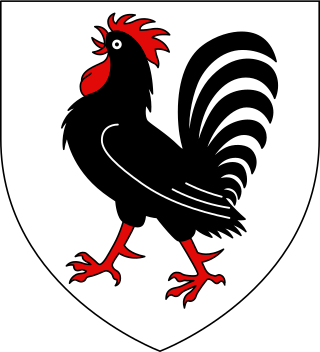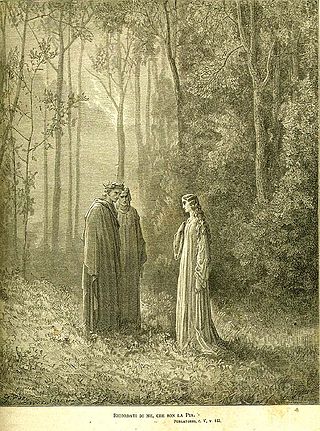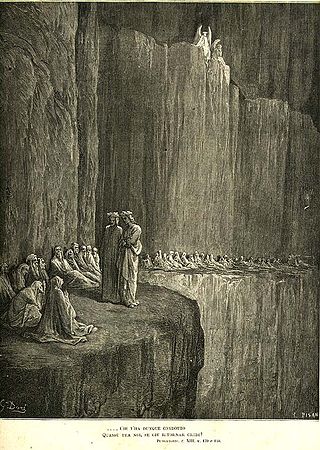
Jacopo del Cassero (Fano, 1260 - Oriago, 1298) was a magistrate and condottiero from late medieval Italy. He appears as a character in Dante Alighieri's Purgatorio .

Jacopo del Cassero (Fano, 1260 - Oriago, 1298) was a magistrate and condottiero from late medieval Italy. He appears as a character in Dante Alighieri's Purgatorio .
Jacopo del Cassero was born in Fano around 1260. He was the son of Uguccione and was part of the powerful Guelph family of Berarda. He was a Guelph magistrate of Fano, and between 1288 and 1289 he participated with the Guelphs of the Marche region allied with Florence in the Battle of Campaldino against the Ghibellines of Arezzo. Here is where he probably met Dante. [1]
Jacopo defended Bologna, a city of which he was mayor from 1296 to 1297, from the expansionist aims of Azzo VIII d'Este, lord of Ferrara. In 1298, Jacopo was elected mayor of Milan, and to reach the city he prudently decided to pass through Venice by sea and continue by land, thus avoiding the territories of the Este family. [1] Despite this, while he was in Padua on the banks of the Brenta, near the marshes that surrounded the castle of Oriago, he was reached by assassins sent by Azzo VIII and was wounded in the leg and groin. He sought shelter in a swamp where he bled to death. [1]
Today his remains rest in the Church of San Pietro in Episcopio in Fano after being kept until 1994 at the Church of San Domenico under the protection of the Madonna del Latte.
Jacopo del Cassero appears as a character in the Divine Comedy, composed between 1308 and 1321, where he is featured in canto 5 of Purgatorio alongside Pia de' Tolomei and Bonconte da Montefeltro.
Dante the pilgrim meets Jacopo among the souls who were victims of violent deaths and repented for their sins in the very last moments of their lives. [1] When these souls first take notice of the pilgrim, they are amazed by his mortal status, and thus flock around him to tell him of their stories. When Jacopo steps forward, he asks Dante to make the truth known to his relatives so that they pray for him and thus his time spent in Ante-Purgatory is shortened. He then proceeded to tell the pilgrim of the moment of his death. [2]

Dante Alighieri, widely known mononymously as Dante, was an Italian poet, writer, and philosopher. His Divine Comedy, originally called Comedìa and later christened Divina by Giovanni Boccaccio, is widely considered one of the most important poems of the Middle Ages and the greatest literary work in the Italian language.

The Divine Comedy is an Italian narrative poem by Dante Alighieri, begun c. 1308 and completed around 1321, shortly before the author's death. It is widely considered the pre-eminent work in Italian literature and one of the greatest works of Western literature. The poem's imaginative vision of the afterlife is representative of the medieval worldview as it existed in the Western Church by the 14th century. It helped establish the Tuscan language, in which it is written, as the standardized Italian language. It is divided into three parts: Inferno, Purgatorio, and Paradiso.

Beatrice "Bice" di Folco Portinari was an Italian woman who has been commonly identified as the principal inspiration for Dante Alighieri's Vita Nuova, and is also identified with the Beatrice who acts as his guide in the last book of his narrative poem the Divine Comedy, Paradiso, and during the conclusion of the preceding Purgatorio. In the Comedy, Beatrice symbolises divine grace and theology.

Purgatorio is the second part of Dante's Divine Comedy, following the Inferno and preceding the Paradiso. The poem was written in the early 14th century. It is an allegory telling of the climb of Dante up the Mount of Purgatory, guided by the Roman poet Virgil—except for the last four cantos, at which point Beatrice takes over as Dante's guide. Allegorically, Purgatorio represents the penitent Christian life. In describing the climb Dante discusses the nature of sin, examples of vice and virtue, as well as moral issues in politics and in the Church. The poem posits the theory that all sins arise from love—either perverted love directed towards others' harm, or deficient love, or the disordered or excessive love of good things.

Sordello da Goito or Sordel de Goit was a 13th-century Italian troubadour. His life and work have inspired several authors including Dante Alighieri, Robert Browning, and Samuel Beckett.
Guido da Montefeltro was an Italian military strategist and lord of Urbino. He became a friar late in life, and was condemned by Dante Alighieri in his Divine Comedy for giving false or fraudulent counsel.
Azzo VIII d'Este was lord of Ferrara, Modena and Reggio from 1293 until his death.

Joannaof Gallura, also known as Giovanna Visconti, was the last titular Judge (giudicessa) of Gallura. Joanna claimed her rights in Sardinia to no avail and eventually sold them to her relatives, the Visconti of Milan, who later sold them to the Crown of Aragon. She is mentioned passingly by Dante Alighieri in the Divine Comedy. Her father, a friend of Dante's, but consigned to Purgatory with the other negligent rulers, asks her to be reminded of him.

Inferno is the first part of Italian writer Dante Alighieri's 14th-century narrative poem The Divine Comedy. It is followed by Purgatorio and Paradiso. The Inferno describes the journey of a fictionalised version of Dante himself through Hell, guided by the ancient Roman poet Virgil. In the poem, Hell is depicted as nine concentric circles of torment located within the Earth; it is the "realm [...] of those who have rejected spiritual values by yielding to bestial appetites or violence, or by perverting their human intellect to fraud or malice against their fellowmen". As an allegory, the Divine Comedy represents the journey of the soul toward God, with the Inferno describing the recognition and rejection of sin.
San Domenico is a deconsecrated Roman Catholic church in the town of Fano, province of Pesaro and Urbino in the Marche, Italy. The deconsecrated church is now used to display the painting collection of the Fondazione Cassa di Risparmio di Fano. The church has been selected to display sacred works and altarpieces from the 16th and 17th centuries in an environment resembling their original placements.

Pia de' Tolomei was an Italian noblewoman from Siena identified as "la Pia," a minor character in Dante's Divine Comedy who was murdered by her husband. Her brief presence in the poem has inspired many works in art, music, literature, and cinema. Her character in the Divine Comedy is noted for her compassion and serves a greater program among the characters in her canto, as well as the female characters in the entire poem.

Matelda, anglicized as Matilda in some translations, is a minor character in Dante Alighieri's Purgatorio, the second canticle of the Divine Comedy. She is present in the final six cantos of the canticle, but is unnamed until Canto XXXIII. While Dante makes Matelda's function as a baptizer in the Earthly Paradise clear, commentators have disagreed about what historical figure she is intended to represent, if any.
Alagia Fieschi, also known as Alagia di Nicolò Fieschi and Alagia di Fieschi, was the daughter of Count Nicolò Fieschi and niece of Pope Adrian V. Alagia married Moroello Malaspina in the 1280s and they had five children. In Dante Alighieri's Divine Comedy, Alagia is remembered by Adrian V at the end of his conversation with Dante as the only virtuous woman in his family whom he wishes to pray on his behalf. Alagia’s mention as the only virtuous person in her family reflects Dante’s view about Alagia's family's actions involving the Malaspina family. In addition, Alagia is celebrated by Dante through his portrayal of her as a virtuous woman whose prayer can contribute to Adrian V's journey of salvation.

Bonconte I da Montefeltro was an Italian Ghibelline general. He led Ghibelline forces in several engagements until his battlefield death. Dante Alighieri featured Montefeltro as a character in the Divine Comedy.
Giovanna da Montefeltro was a thirteenth-century Italian noblewoman and the wife of Bonconte I da Montefeltro. She is referenced by Dante Alighieri in his Divine Comedy for not remembering her late husband in her prayers.

Sapia Salvani was a Sienese noblewoman. In Dante Alighieri's Divine Comedy, she is placed among the envious souls of Purgatory for having rejoiced when her fellow Sienese townspeople, led by her nephew Provenzano Salvani, lost to the Florentine Guelphs at the Battle of Colle Val d'Elsa.

Beatrice d’Este was an Italian noblewoman, now primarily known for Dante Alighieri's allusion to her in Purgatorio, the second canticle of the Divine Comedy. Through her first marriage to Nino Visconti, she was judge (giudichessa) of Gallura, and through her second marriage to Galeazzo I Visconti, following Nino’s death, lady of Milan.

The third circle of hell is depicted in Dante Alighieri's Inferno, the first part of the 14th-century poem Divine Comedy. Inferno tells the story of Dante's journey through a vision of the Christian hell ordered into nine circles corresponding to classifications of sin; the third circle represents the sin of gluttony, where the souls of the gluttonous are punished in a realm of icy mud.
Marco da Saliceto was an Italian notary and administrator from Bologna, who served as a tutor of the future monarch Andrew III of Hungary. Some scholars identified him with Marco Lombardo, a character in Dante's Purgatorio.